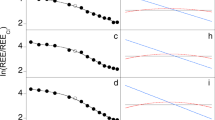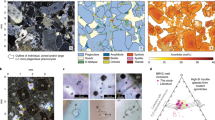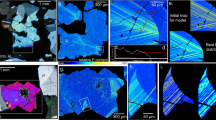Abstract
The structure and composition of granites provide clues to the nature of silicic volcanism, the formation of continents, and the rheological and thermal properties of the Earth's upper crust as far back as the Hadean eon during the nascent stages of the planet’s formation1,2,3,4. The temperature of granite crystallization underpins our thinking about many of these phenomena, but evidence is emerging that this temperature may not be well constrained. The prevailing paradigm holds that granitic mineral assemblages crystallize entirely at or above about 650–700 degrees Celsius5,6,7. The granitoids of the Tuolumne Intrusive Suite in California tell a different story. Here we show that quartz crystals in Tuolumne samples record crystallization temperatures of 474–561 degrees Celsius. Titanium-in-quartz thermobarometry and diffusion modelling of titanium concentrations in quartz indicate that a sizeable proportion of the mineral assemblage of granitic rocks (for example, more than 80 per cent of the quartz) crystallizes about 100–200 degrees Celsius below the accepted solidus. This has widespread implications. Traditional models of magma formation require high-temperature magma bodies, but new data8,9 suggest that volcanic rocks spend most of their existence at low temperatures; because granites are the intrusive complements of volcanic rocks, our downward revision of granite crystallization temperatures supports the observations of cold magma storage. It also affects the link between volcanoes, ore deposits and granites: ore bodies are fed by the release of fluids from granites below them in the crustal column; thus, if granitic fluids are hundreds of degrees cooler than previously thought, this has implications for research on porphyry ore deposits. Geophysical interpretations of the thermal structure of the crust and the temperature of active magmatic systems will also be affected.
This is a preview of subscription content, access via your institution
Access options
Access Nature and 54 other Nature Portfolio journals
Get Nature+, our best-value online-access subscription
$29.99 / 30 days
cancel any time
Subscribe to this journal
Receive 51 print issues and online access
$199.00 per year
only $3.90 per issue
Buy this article
- Purchase on Springer Link
- Instant access to full article PDF
Prices may be subject to local taxes which are calculated during checkout




Similar content being viewed by others
References
Buret, Y. et al. From a long-lived upper-crustal magma chamber to rapid porphyry copper emplacement: reading the geochemistry of zircon crystals at Bajo de la Alumbrera (NW Argentina). Earth Planet. Sci. Lett. 450, 120–131 (2016).
Comeau, M. J., Unsworth, M. J. & Cordell, D. New constraints on the magma distribution and composition beneath Volcán Uturuncu and the southern Bolivian Altiplano from magnetotelluric data. Geosphere 12, 1391–1421 (2016).
Hacker, B. R., Kelemen, P. B. & Behn, M. D. Continental lower crust. Annu. Rev. Earth Planet. Sci. 43, 167–205 (2015).
Reimink, J. R., Chacko, T., Stern, R. A. & Heaman, L. M. Earth’s earliest evolved crust generated in an Iceland-like setting. Nat. Geosci. 7, 529–533 (2014).
Luth, W. C., Jahns, R. H. & Tuttle, O. F. The granite system at pressures of 4 to 10 kilobars. J. Geophys. Res. 69, 759–773 (1964).
Piwinskii, A. J. Experimental studies of granitoids from the Central and Southern Coast Ranges, California. Tschermaks Mineral. Petrogr. Mitt. 20, 107–130 (1973).
Tuttle, O. F. & Bowen, N. L. Origin of granite in the light of experimental studies in the system NaAlSi3O8–KAlSi3O8–SiO2–H2O. Geol. Soc. Am. 74, 1–146 (1958).
Rubin, A. E. et al. Rapid cooling and cold storage in a silicic magma reservoir recorded in individual crystals. Science 356, 1154–1156 (2017).
Andersen, N. L., Jicha, B. R., Singer, B. S. & Hildreth, W. Incremental heating of Bishop Tuff sanidine reveals preeruptive radiogenic Ar and rapid remobilization from cold storage. Proc. Natl Acad. Sci. USA 114, 12407–12412 (2017).
Coleman, D. S., Gray, W. & Glazner, A. F. Rethinking the emplacement and evolution of zoned plutons: geochronologic evidence for incremental assembly of the Tuolumne Intrusive Suite. Calif. Geol. 32, 433–436 (2004).
Huang, H.-H. et al. The Yellowstone magmatic system from the mantle plume to the upper crust. Science 348, 773–776 (2015).
Glazner, A. F. & Johnson, B. R. Late crystallization of K-feldspar and the paradox of megacrystic granites. Contrib. Mineral. Petrol. 166, 777–799 (2013).
Challener, S. C. & Glazner, A. F. Igneous or metamorphic? Hornblende phenocrysts as greenschist facies reaction cells in the Half Dome Granodiorite, California. Am. Mineral. 102, 436–444 (2017).
Gray, W., Glazner, A. F., Coleman, D. S. & Bartley, J. M. Long-term geochemical variability of the Late Cretaceous Tuolumne Intrusive Suite, central Sierra Nevada, California. Geol. Soc. Lond. Spec. Publ. 304, 183–201 (2008).
Schairer, J. F. & Bowen, N. L. Melting relations in the systems Na2O–Al2O3–SiO2 and K2O–Al2O3–SiO2. Am. J. Sci. 245, 193–204 (1947).
Tuttle, O. F. & Friedman, I. I. Liquid immiscibility in the system H2O–Na2O–SiO2. J. Am. Chem. Soc. 70, 919–926 (1948).
Huang, F. et al. Chemical and isotopic fractionation of wet andesite in a temperature gradient: experiments and models suggesting a new mechanism of magma differentiation. Geochim. Cosmochim. Acta 73, 729–749 (2009).
Thomas, J. B. et al. TitaniQ under pressure: the effect of pressure and temperature on the solubility of Ti in quartz. Contrib. Mineral. Petrol. 160, 743–759 (2010).
Lackey, J. S., Valley, J. W., Chen, J. H. & Stockli, D. F. dynamic magma systems, crustal recycling, and alteration in the Central Sierra Nevada Batholith: the oxygen isotope record. J. Petrol. 49, 1397–1426 (2008).
Huang, R. & Audétat, A. The titanium-in-quartz (TitaniQ) thermobarometer: a critical examination and re-calibration. Geochim. Cosmochim. Acta 84, 75–89 (2012).
Spear, F. S. & Wark, D. A. Cathodoluminescence imaging and titanium thermometry in metamorphic quartz. J. Metamorph. Geol. 27, 187–205 (2009).
Davis, J. W., Coleman, D. S., Gracely, J. T., Gaschnig, R. & Stearns, M. Magma accumulation rates and thermal histories of plutons of the Sierra Nevada batholith, CA. Contrib. Mineral. Petrol. 163, 449–465 (2012).
Bateman, P. C. & Chappell, B. W. Crystallization, fractionation, and solidification of the Tuolumne Intrusive Series, Yosemite National Park, California. Geol. Soc. Am. Bull. 90, 465–482 (1979).
Lundstrom, C. C. The role of thermal migration and low-temperature melt in granitoid formation: can granite form without rhyolitic melt? Int. Geol. Rev. 58, 371–388 (2016).
Moore, J. G. & Sisson, T. W. Igneous phenocrystic origin of K-feldspar megacrysts in granitic rocks from the Sierra Nevada batholith. Geosphere 4, 387–400 (2008).
Vigneresse, J. L., Barbey, P. & Cuney, M. Rheological transitions during partial melting and crystallization with application to felsic magma segregation and transfer. J. Petrol. 37, 1579–1600 (1996).
Plümper, O. & Putnis, A. The complex hydrothermal history of granitic rocks: multiple feldspar replacement reactions under subsolidus conditions. J. Petrol. 50, 967–987 (2009).
Seitz, S. et al. Short magmatic residence times of quartz phenocrysts in Patagonian rhyolites associated with Gondwana breakup. Geology 44, 67–70 (2016).
Cherniak, D. J., Watson, E. B. & Wark, D. A. Ti diffusion in quartz. Chem. Geol. 236, 65–74 (2007).
Crank, J. The Mathematics of Diffusion (Clarendon, New York, 1979).
Ague, J. J. & Brimhall, G. H. Magmatic arc asymmetry and distribution of anomalous plutonic belts in the batholiths of California: effects of assimilation, crustal thickness, and depth of crystallization. Geol. Soc. Am. Bull. 100, 912–927 (1988).
Memeti, V., Paterson, S., Matzel, J., Mundil, R. & Okaya, D. Magmatic lobes as ‘snapshots’ of magma chamber growth and evolution in large, composite batholiths: an example from the Tuolumne intrusion, Sierra Nevada, California. Geol. Soc. Am. Bull. 122, 1912–1931 (2010).
Leeman, W. P. et al. A study of cathodoluminescence and trace element compositional zoning in natural quartz from volcanic rocks: mapping titanium content in quartz. Microsc. Microanal. 18, 1322–1341 (2012).
Spear, F. S., Ashley, K. T., Webb, L. E. & Thomas, J. B. Ti diffusion in quartz inclusions: implications for metamorphic time scales. Contrib. Mineral. Petrol. 164, 977–986 (2012).
Johnson, B. R. & Glazner, A. F. Formation of K-feldspar megacrysts in granodioritic plutons by thermal cycling and late-stage textural coarsening. Contrib. Mineral. Petrol. 159, 599–619 (2010).
Anderson, J. L. Status of thermobarometry in granitic batholiths. Earth Environ. Sci. Trans. R. Soc. Edinb. 87, 125–138 (1996).
Hecht, L., Thuro, K., Plinninger, R. & Cuney, M. Mineralogical and geochemical characteristics of hydrothermal alteration and episyenitization in the Königshain granites, northern Bohemian Massif, Germany. Int. J. Earth Sci. 88, 236–252 (1999).
Wark, D. A. & Watson, E. B. TitaniQ: a titanium-in-quartz geothermometer. Contrib. Mineral. Petrol. 152, 743–754 (2006).
Ostapenko, G. T., Tarashchan, A. N. & Mitsyuk, B. M. Rutile–quartz geothermobarometer. Geochem. Int. 45, 506–508 (2007).
Wilson, C. J. N., Seward, T. M., Allan, A. S. R., Charlier, B. L. A. & Bello, L. A comment on: ‘TitaniQ under pressure: the effect of pressure and temperature on the solubility of Ti in quartz’, by Jay B. Thomas, E. Bruce Watson, Frank S. Spear, Philip T. Shemella, Saroj K. Nayak and Antonio Lanzirotti. Contrib. Mineral. Petrol. 164, 359–368 (2012).
Ghiorso, M. S. & Gualda, G. A. R. A method for estimating the activity of titania in magmatic liquids from the compositions of coexisting rhombohedral and cubic iron–titanium oxides. Contrib. Mineral. Petrol. 165, 73–81 (2013).
Lanzillo, N. A., Watson, E. B., Thomas, J. B., Nayak, S. K. & Curioni, A. Near-surface controls on the composition of growing crystals: Car–Parrinello molecular dynamics (CPMD) simulations of Ti energetics and diffusion in alpha quartz. Geochim. Cosmochim. Acta 131, 33–46 (2014).
Thomas, J. B., Watson, E. B., Spear, F. S. & Wark, D. A. TitaniQ recrystallized: experimental confirmation of the original Ti-in-quartz calibrations. Contrib. Mineral. Petrol. 169, 27 (2015).
Watson, E. B., Wark, D. A. & Thomas, J. B. Crystallization thermometers for zircon and rutile. Contrib. Mineral. Petrol. 151, 413–433 (2006).
Hayden, L. A. & Watson, E. B. Rutile saturation in hydrous siliceous melts and its bearing on Ti-thermometry of quartz and zircon. Earth Planet. Sci. Lett. 258, 561–568 (2007).
Glazner, A. F., Coleman, D. S. & Bartley, J. M. The tenuous connection between high-silica rhyolites and granodiorite plutons. Geology 36, 183–186 (2008).
Thomas, J. B. & Watson, E. B. Application of the Ti-in-quartz thermobarometer to rutile-free systems. Reply to: a comment on: ‘TitaniQ under pressure: the effect of pressure and temperature on the solubility of Ti in quartz’ by Thomas et al. Contrib. Mineral. Petrol. 164, 369–374 (2012).
Anderson, J. L. & Smith, D. R. The effects of temperature and fO2 on the Al-in-hornblende barometer. Am. Mineral. 80, 549–559 (1995).
Putirka, K. D. Thermometers and barometers for volcanic systems. Rev. Mineral. Geochem. 69, 61–120 (2008).
Trail, D., Bindeman, I. N., Watson, E. B. & Schmitt, A. K. Experimental calibration of oxygen isotope fractionation between quartz and zircon. Geochim. Cosmochim. Acta 73, 7110–7126 (2009).
Acknowledgements
All data for this manuscript are reported in the Extended Data. This research was supported by the Carnegie Institution of Washington’s Postdoctoral Fellowship Program and the NASA Astrobiology Institute (grant NNA09DA80A) to the New York Center for Astrobiology. We thank N. Ackerson, M. J. Ackerson and V. Ackerson for assistance in the field, E. Bullock and J. Armstrong for their technical assistance in analysing quartz, and D. Coleman, J. Reimink, L. Wagner, H. Le Mével, S. Shirey and P. Ulmer for conversations during manuscript preparation.
Author information
Authors and Affiliations
Contributions
M.R.A. contributed the main ideas behind this study, analyses and writing of the manuscript. B.O.M., N.D.T. and E.B.W. provided critical expertise in the development of the proposed models. E.B.W. also contributed the diffusion model code.
Corresponding author
Ethics declarations
Competing interests
The authors declare no competing interests.
Additional information
Publisher’s note: Springer Nature remains neutral with regard to jurisdictional claims in published maps and institutional affiliations.
Extended data figures and tables
Extended Data Fig. 1 Modified geological map of the TIS with sample locations.
Geological map modified from ref. 10.
Extended Data Fig. 2 Secondary fluorescence analyses of Ti concentrations in quartz as a function of distance from an adjacent titanite crystal.
Analyses of the Ti of a quartz crystal from the Glen Aulin tonalite (Kga) show a rimward increase in Ti towards an adjacent titanite crystal. This increase in Ti content is due to a secondary fluorescence of Ti from the nearby titanite crystal. Error bars are 1σ.
Extended Data Fig. 3 Blue-filtered cathodoluminescence images of quartz from the TIS demonstrate both primary crystallization features and features that suggest alteration of the initial Ti content.
a, Quartz from the Glen Aulin tonalite. b, Quartz from the equigranular Half Dome granodiorite has a centre-to-rim decrease in Ti content consistent with lower-temperature crystallization. c, d, In contrast, other quartz crystals from the equigranular Half Dome granodiorite exhibit complex cathodoluminescence features suggesting that the primary Ti content of the quartz has been altered by syn-magmatic deformation. e, f, Quartz from the Cathedral Peak granodiorite displays a series of primary magmatic growth features suggesting thermal cycling and dissolution-recrystallization of quartz. Lines are microprobe traverses.
Extended Data Fig. 4 Comparison of calibrations of the Ti-in-quartz thermobarometer.
a, Calibration by Thomas et al.18; b, calibration by Huang and Audétat20. Although the Huang and Audétat20 calibration could yield near-solidus temperatures for 20–40 p.p.m. Ti in quartz, these high temperatures cannot explain the sharp Ti concentration zones in quartz crystals, which could only be retained if the quartz crystallized at low temperatures (Fig. 3).
Extended Data Fig. 5 Core–rim Ti concentration profiles in quartz compared with a constant-cooling rate diffusion model.
Diffusion model from Fig. 3b. a, Cathodoluminescence (452 nm) map image of a quartz crystal from the Cathedral Peak granodiorite from approximately the core (upper left) to the rim (right and bottom). Coloured lines are profiles seen in b. b, Normalized concentration gradients from profiles across the grain combined with the diffusion model from Fig. 3b indicate that initial crystallization temperatures must have been below the traditional solidus at about 700 °C for almost the entirety of the observed quartz crystal. For simplicity, high concentrations are all plotted on the left, regardless of position within the crystal. At the scale of these profiles, this simplification does not noticeably change the modelled profiles (that is, it does not matter if the high concentration is coreward or rimward). A second example from the Cathedral Peak granodiorite also contains core (top) to rim (bottom) cathodoluminescence (c) and corresponding concentration gradient profiles that indicate low temperature crystallization for the entire crystal (d).
Extended Data Fig. 6 The influence of cooling rate on the results of constant-cooling rate diffusion models.
a–c, Diffusion modelling at 10 °C per million years (10 °C Myr−1; a), 36.36 °C Myr−1 (b) and 100 °C Myr−1 (c). Faster cooling rates will lead to less diffusion. However, even at rapid cooling rates (for example, 100 °C Myr−1), the modelled profiles do not match the observed Ti concentrations.
Extended Data Fig. 7 Estimating the volume of low-temperature quartz crystallization when diffusion modelling is intractable.
a, Cathodoluminescence (452 nm) image of a centre-cut quartz crystal from the Half Dome granodiorite. This crystal has internal Ti concentrations as high as 101 p.p.m. Concentric circles are contours showing the percentage of total volume crystallized at that radius, assuming spherical quartz growth. Using 60 p.p.m. Ti as a rough approximation for high-T quartz crystallization (denoted with a bold dot-dashed polygon), this volume approximation demonstrates that only around 10% of the quartz could have crystallized at solidus or supersolidus temperatures. b, Radius of crystal (approximately 590 µm) versus the total volume of quartz crystallized at a given radius for a spherical quartz crystal with r = 590 µm.
Extended Data Fig. 8 Low-temperature indicators from other minerals in the TIS.
In addition to quartz, feldspar compositions and oxygen isotope fractionation between quartz and zircon results in subsolidus temperatures. Two-feldspar temperatures are calculated using three different calibrations (equations (27a), (27b) and a global regression from ref. 49). Zircon–quartz oxygen isotope fractionation temperatures are calculated using averaged oxygen isotope compositions from quartz and zircon from individual units in the TIS19 and an experimentally calibrated zircon–quartz fractionation relationship50.
Rights and permissions
About this article
Cite this article
Ackerson, M.R., Mysen, B., Tailby, N. et al. Low-temperature crystallization of granites and the implications for crustal magmatism. Nature 559, 94–97 (2018). https://doi.org/10.1038/s41586-018-0264-2
Received:
Accepted:
Published:
Issue Date:
DOI: https://doi.org/10.1038/s41586-018-0264-2
This article is cited by
-
Diapirs of crystal-rich slurry explain granite emplacement temperature and duration
Scientific Reports (2023)
-
TitaniQ revisited: expanded and improved Ti-in-quartz solubility model for thermobarometry
Contributions to Mineralogy and Petrology (2022)
-
Zircon petrochronology in large igneous provinces reveals upper crustal contamination processes: new U–Pb ages, Hf and O isotopes, and trace elements from the Central Atlantic magmatic province (CAMP)
Contributions to Mineralogy and Petrology (2021)
-
29Si solid state NMR and Ti K-edge XAFS pre-edge spectroscopy reveal complex behavior of Ti in silicate melts
Progress in Earth and Planetary Science (2020)
-
Aplite diking and infiltration: a differentiation mechanism restricted to plutonic rocks
Contributions to Mineralogy and Petrology (2020)
Comments
By submitting a comment you agree to abide by our Terms and Community Guidelines. If you find something abusive or that does not comply with our terms or guidelines please flag it as inappropriate.



